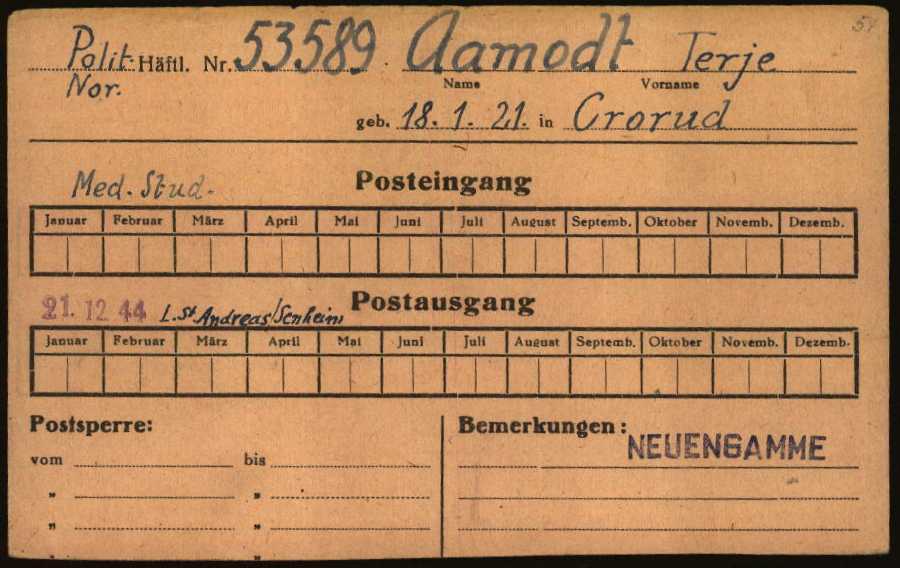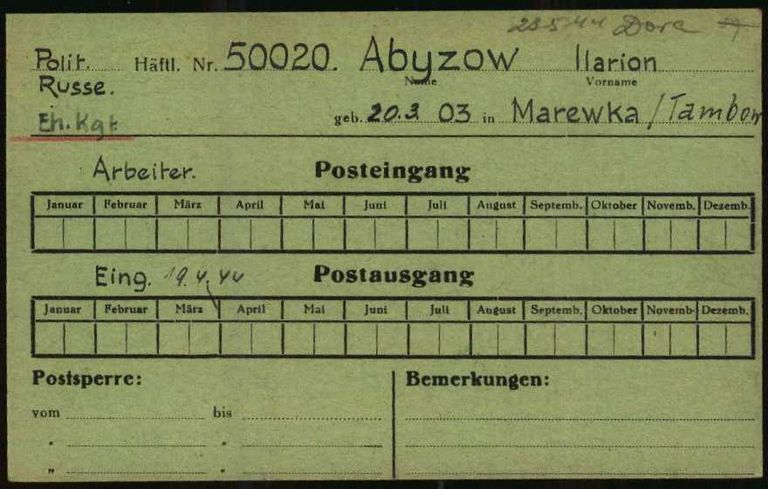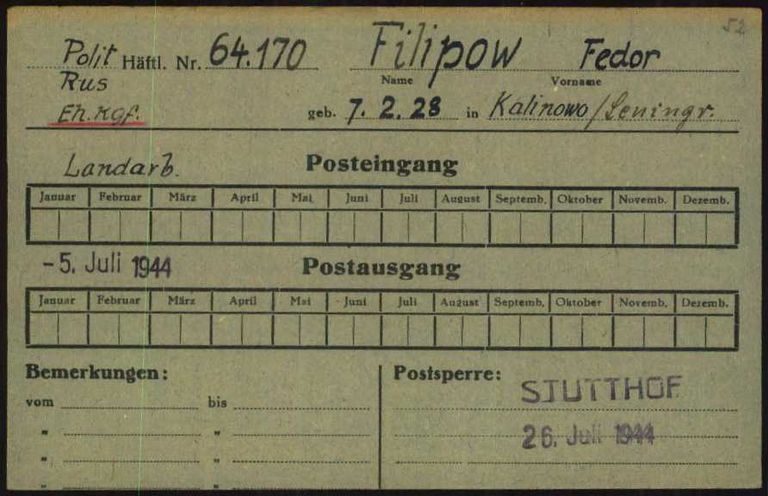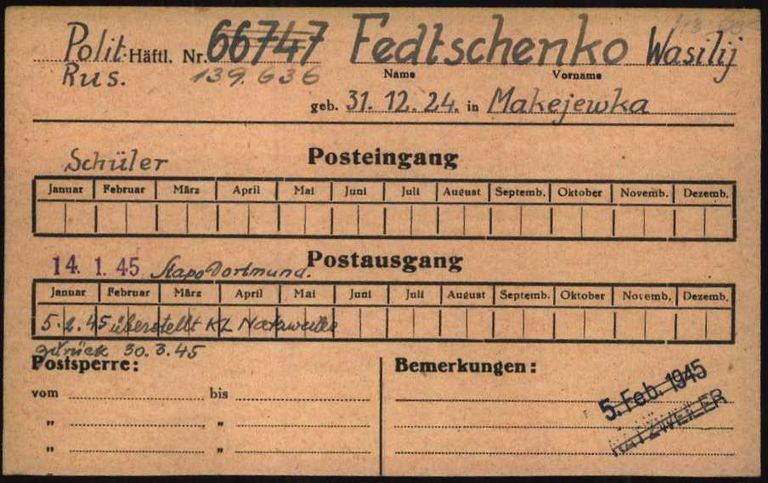Page of
Page/
- Reference
- Intro


These post control cards were used to manage the incoming and outgoing mail of concentration camp prisoners. The cards appear in different colors in the Arolsen Archives, but the color of the paper has no bearing on the content. Other more or less detailed information can also be found on the post control cards, such as the prisoners’ occupations and the camps from which they had come or to which they had been transferred. In many cases, absolutely no correspondence has been recorded on the cards because, particularly during the war, prisoners often did not know where their relatives were or where they should send letters.
These post control cards were used to manage the incoming and outgoing mail of concentration camp prisoners. The cards appear in different colors in the Arolsen Archives, but the color of the paper has no bearing on the content. Other more or less detailed information can also be found on the post control cards, such as the prisoners’ occupations and the camps from which they had come or to which they had been transferred. In many cases, absolutely no correspondence has been recorded on the cards because, particularly during the war, prisoners often did not know where their relatives were or where they should send letters.
Questions and answers
-
Where was the document used and who created it?
Post control cards (abbreviated as P.K.K.) were issued in what was known as the camp registry office when prisoners arrived at a concentration camp. The prisoner functionaries working in this office would transfer information such as the prisoner’s date of birth, name and prisoner number from the arrivals form, which would have previously been filled out for all prisoners, to the post control card. The registry office would then forward the post control card via the block elders to the respective block leaders.These block leaders managed the postal card files in the various blocks of the camp.
The main camps were responsible for handling the correspondence and censoring the letters of prisoners in the sub-camps as well. Letters and packages would be forwarded to the sub-camps, where they were distributed by labor detail leaders or camp elders.
- When was the document used?
The post control cards in the Arolsen Archives cover the entire period in which the concentration camps existed. One striking aspect of the later cards from the 1940s is that they rarely record any correspondence at all. This indicates that many prisoners were cut off from the outside world in the last years of the war and often did not know the location of any family members they could write to.
- What was the document used for?
Most prisoners were officially allowed to send and receive letters at certain intervals in the concentration camps. Some groups of prisoners, such as Soviet prisoners of war, were excluded from this, however. There could also be special regulations for Jewish prisoners or so-called “Bible Students” (Jehovah’s Witnesses), for example, which prohibited them from sending and receiving letters as frequently as other prisoners.
Prisoners in the concentration camps had to write letters on pre-printed forms which were then censored by SS men and female SS guards. This was supposed to prevent news about conditions in the camp from reaching the outside world. Additionally, non-German-speaking prisoners were only allowed to write letters and postcards in German. This rule was established because the SS would not have been able to censor texts in foreign languages.
The amount of permitted correspondence changed frequently over the years. In Dachau, for example, prisoners were initially only allowed to write and receive one letter a month, but from 1934 onwards it was two. To monitor this, the date on which a person received or sent mail was noted on their post control card. Block leaders could also see at a glance whether there were any restrictions, such as whether the owner of the card had been forbidden to send or receive mail for a period of time as a punishment.
Rules similar to those in the main camps also applied in the sub-camps. In a letter from December 1944 that has been preserved in the Arolsen Archives, rules were defined for correspondence in the external labor details of Buchenwald. According to these rules, the prisoners were allowed to send one letter and receive one letter each month. Stricter rules applied to Jewish prisoners; they were only allowed to write one letter and receive one letter every eight weeks. At this point in time, all prisoners were prohibited from corresponding with anyone in the General Government, and letters to the Red Cross were also not allowed. To prevent a prisoner’s relatives from finding out that the prisoner was in a sub-camp, the sender’s address would be printed on the blank forms as K.L. Buchenwald, Block 17 (for all Buchenwald external labor details in a radius of up to 100 km from the main camp), for example, or Block W (for the Wittenberge external labor detail of Neuengamme).
- How common is the document?
In an instruction for the prisoner registry office of Buchenwald, the post control card is mentioned as one of four cards to be filled out for all new prisoners. However, the Arolsen Archives do not have a post control card for every former prisoner. It is not possible to say exactly how many post control cards are preserved in the Arolsen Archives, but a list from the year 1951 mentions – as a rough framework – 150,000 post control cards from Buchenwald and just over 1,000 from the Natzweiler concentration camp. In the collection of individual documents from the Mittelbau-Dora concentration camp, 45,000 post control cards have been preserved, although a different form was generally used there.
- What should be considered when working with the document?
Since no camp names were printed on the post control cards, it is not possible to directly determine in which concentration camp they were issued. Sometimes, however, additional information was written by hand on the cards that was not strictly related to postal correspondence. For example, some cards note the prisoner’s arrival, transfer or occupation. This information can be found in various places on the cards since there was no specific field set aside for it. If a camp is mentioned on a card, it is not always clear whether the prisoner had come from that camp or been transferred to it. In these cases, other documents must be used to check the information and reconstruct the prisoner’s path of persecution.
The post control cards suggest that prisoners could write and receive letters. Even if this was theoretically possible in most cases, it is important to remember that particularly in the second half of the war, very few prisoners were in postal contact with their families or friends. Many former prisoners recall that they received absolutely no signs of life from their relatives. The prisoners themselves often did not know the location of the people they would have wanted to contact. In the wake of mass deportations in particular, when entire families were deported to different concentration camps, prisoners often simply did not know where to write to. The fact that these post control cards existed does not mean that postal correspondence was actually possible.
If you have any additional information about this document or any other documents described in the e-Guide, we would appreciate it very much if you could send your feedback to eguide@arolsen-archives.org. The document descriptions are updated regularly – and the best way for us to do this is by incorporating the knowledge you share with us.
Variations
Help for documents
About the scan of this document <br> Markings on scan <br> Questions and answers about the document <br> More sample cards <br> Variants of the document




